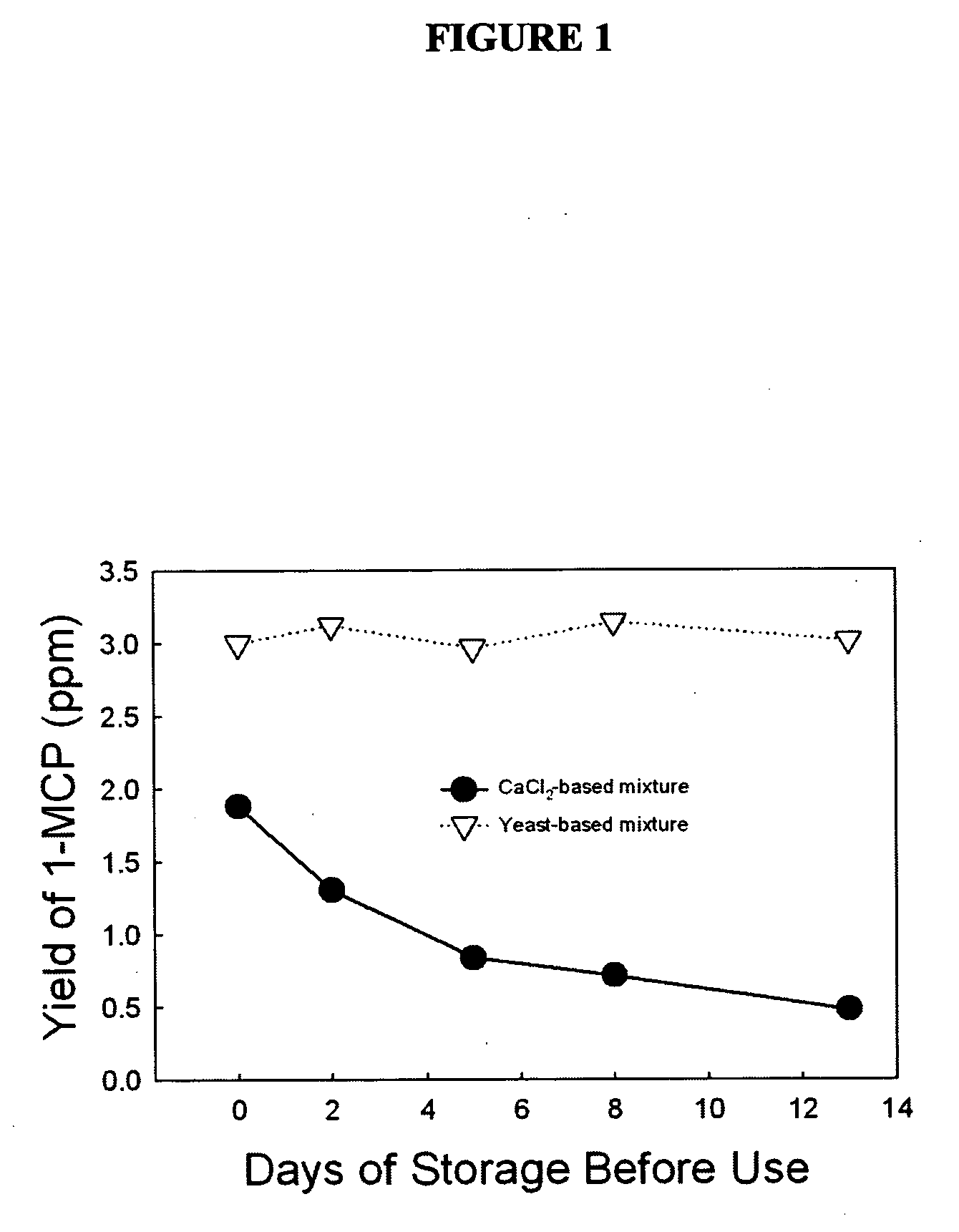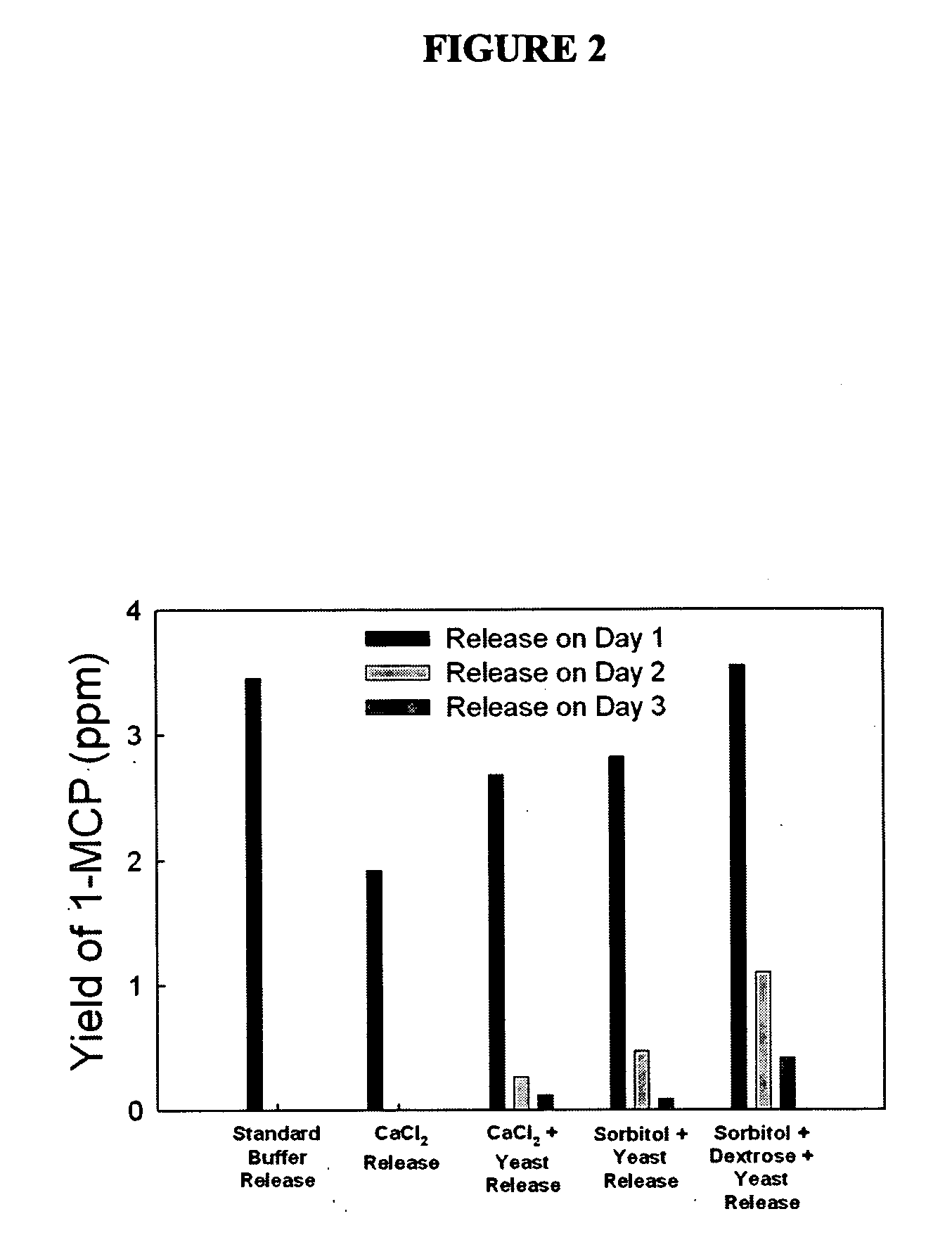Compositions and methods to improve the storage quality of packaged plants
a technology applied in the field of compositions and methods, can solve the problems that commercial technologies or regulatory approvals for these crops have not been pursued, and the i-mcp treatment alone cannot overcome the propensity for the product to decay, so as to prolong the release of cyclopropene, improve shelf stability, and improve the efficiency of cyclopropene release
- Summary
- Abstract
- Description
- Claims
- Application Information
AI Technical Summary
Benefits of technology
Problems solved by technology
Method used
Image
Examples
example 1
Relative Shelf Stability
[0079] Technology developed at Michigan State University for improving the storage quality of packaged plants is based on the use of hygroscopic salts such as CaCl2 in the presence of cyclodextrin immobilized 1-MCP. 1-MCP liquefies and the resultant liquid interacts with the immobilizing cyclodextrin matrix to effect release of 1-MCP (Sittipod, S. ibid). A test was conducted to compare the shelf stability of the technology proposed by Michigan State University and the co-release technology of the present invention. The test involved the formulation of each technology and production of five units of each formulation. On the day of production, one unit of each technology was enclosed in a humidified container and the release of 1-MCP was monitored using gas chromatography. This was repeated four more times, on days 2, 5, 8, and 13, after the sachets were made. The sachets were stored in sealed plastic bags until they were used. It can be seen in FIG. 1 that th...
example 2
Comparison of Co-Release Formulations for 1-MCP, Ethanol, and Acetaldehyde
[0080] Tests were conducted to evaluate a variety of co-release formulations, in particular with respect to their ability to release 1-MCP, produce ethanol and acetaldehyde and the duration of the release of these substances. The control for this was a standard release of 1-MCP from cyclodextrin using a buffer solution. The Michigan State University formulation (CaCl2 and 1-MCP immobilized in cyclodextrin) was used as a second control. A yeast mixture was added to the Michigan CaCl2-based formulation as the first possible 9 co-release technology under consideration. A second co-release mixture was formulated using sorbitol as a hygroscopic agent in lieu of CaCl2, with a yeast mixture and the cyclodextrin-immobilized 1-MCP. A third co-release mixture was formulated using sorbitol, dextrose, and a mixture of yeasts plus the cyclodextrin-immobilized 1-MCP. FIG. 2 shows that the standard buffer release produces a...
example 3
Efficacy of Co-release Technology
(a) Stone Fruit
[0083] Testing has shown the formulations of the present invention to be ideal for maintaining the quality of stone fruits. The composition of the formulation in this example was 6% bakers yeast (Type II), 7% inactivated yeast, 71% sorbitol, 7% dextrose and 9% 1-MCP encapsulated in cyclodextrin. Sweet cherries have been shown to maintain fresh-like quality over three weeks using the technology (FIG. 5). Peaches, nectarines, and apricots have all maintained just-picked quality after three to four weeks of storage at 15-20° C. when using the co-release technology of the present invention. An example of typical results obtained using the co-release technology is shown for apricots in FIG. 6. The formulations of the present invention will be useful particularly in mixtures containing fruits such as melons, apples, pears, other climacteric-type fruits, as well as vegetables such as tomatoes, lettuce, onions, carrots, cabbage, broccoli an...
PUM
 Login to View More
Login to View More Abstract
Description
Claims
Application Information
 Login to View More
Login to View More - R&D
- Intellectual Property
- Life Sciences
- Materials
- Tech Scout
- Unparalleled Data Quality
- Higher Quality Content
- 60% Fewer Hallucinations
Browse by: Latest US Patents, China's latest patents, Technical Efficacy Thesaurus, Application Domain, Technology Topic, Popular Technical Reports.
© 2025 PatSnap. All rights reserved.Legal|Privacy policy|Modern Slavery Act Transparency Statement|Sitemap|About US| Contact US: help@patsnap.com



